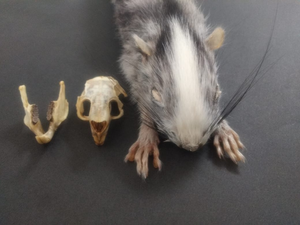Drawn tree spiny rat
| Drawn tree spiny rat | ||||||||||||
|---|---|---|---|---|---|---|---|---|---|---|---|---|

Drawn tree spiny rat ( Callistomys pictus ) |
||||||||||||
| Systematics | ||||||||||||
|
||||||||||||
| Scientific name of the genus | ||||||||||||
| Callistomys | ||||||||||||
| Emmons & Vucetich , 1998 | ||||||||||||
| Scientific name of the species | ||||||||||||
| Callistomys pictus | ||||||||||||
| ( Pictet , 1841) |
The drawn tree rat ( Callistomys pictus ) is a rodent in the family of sting rats that is found in South America. It has been the only species in the genus Callistomys since 1998 .
Taxonomy
Before the genus Callistomys was introduced, the animal's taxonomic status was unclear. It has been listed by different authors in different genus of the sting rats. The scientific name of the new genus is formed from the Greek words καλός ( kalós ) for beautiful and μῦς ( mûs ) for mouse. The specific epithet is Latin and means colored.
According to a 2014 study, the tree spiny rat is more closely related to the beaver rat ( Myocastor coypus ) than to other spiny rats. Both species form a clade in the tribe Myocastorini within the subfamily actual spiny rats (Echimyinae).
The newly formed genus Callistomys includes an extinct species, Callistomys villosus , which was initially assigned to the now disbanded genus Lasiuromys . Lasiuromys is a synonym of the brush tail rats ( Isothrix ).
features
The second part of the German common name refers to the originally presumed belonging to the tree sting rats ( Diplomys ) - however, there are no spines mixed into the fur. The long and dense fur on the top is made up of soft hairs that are brown near the root, while the outer section is black or white in color. The black-tipped hair forms a saddle-shaped, clearly delineated pattern from the shoulders to the rear. The hair has white tips on the rest of the trunk. Another black spot is on the top of the head. The front part of the tail is black on top, followed by a short white tip. The underside of the tail is yellowish. The drawn tree rat has long, narrow vibrissae , which reach the shoulders as far as they are bent backwards.
With a head body length of 25.0 to 29.5 cm and a tail length of 27.3 to 32.5 cm, the species is significantly smaller than the marsh beaver. The hind feet are 4.3 to 4.7 cm long and reach a length of about 1.6 cm.
distribution
The species lives in the east of the state of Bahia in Brazil near the Atlantic . She lives in the rainforests in the lowlands and occasionally visits cocoa plantations.
status
With 13 known specimens in 2016, the species is very rare. In addition, their existence is threatened when forests are converted into agricultural areas and traffic routes. The exact population size is unknown, but it is believed that it will decrease. The IUCN lists the marked tree prickly rat as Endangered .
Individual evidence
- ↑ Don E. Wilson , DeeAnn M. Reeder (Ed.): Mammal Species of the World . A taxonomic and geographic Reference . 3. Edition. 2 volumes. Johns Hopkins University Press, Baltimore MD 2005, ISBN 0-8018-8221-4 (English, Callistomys ).
- ↑ a b c d L. H. Emmons & MG Vucetich: The Identity of Winge's Lasiuromys villosus and the Description of a New Genus of Echimyid Rodent . (PDF) In: American Museum Novitates . No. 3223, 1998, p. 12 pp.
- ^ Loss, Ana; Moura, Raquel T .; Leite, Yuri LR: Unexpected phylogenetic relationships of the painted tree rat Callistomys pictus (Rodentia: Echimyidae) . (PDF) In: Natureza on line . 12, No. 3, 2014, pp. 132-136.
- ↑ a b Callistomys pictus in the endangered Red List species the IUCN 2017. Posted by: Roach, N. & Naylor, L., 2016. Accessed November 24, 2018th
Web links
- Image on ARKive